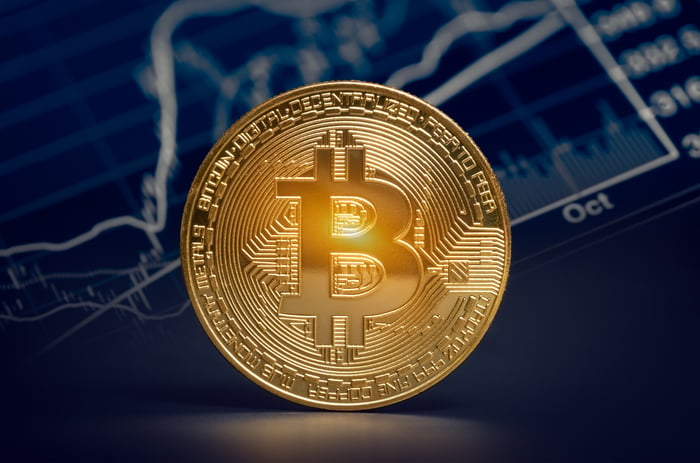If you think the 11-month rally in the three major stock market indexes is impressive, you probably haven't been paying close enough attention to Bitcoin (BTC -0.43%). The world's largest cryptocurrency by market cap has tripled over the past three months, is up more than 480% over the trailing year, and has vaulted higher by 12,710% on a trailing five-year basis. For context, the benchmark S&P 500 is up 104% over the trailing five-year period.
Bitcoin has had the usual array of tailwinds in its sails during its latest bull run. These catalysts include the perception of scarcity -- i.e., its 21 million token limit will be a store of value against a growing U.S. and global money supply -- and the growing acceptance of Bitcoin by businesses as a form of payment.
The world's first trillion-dollar crypto token has also been buoyed by bullish tweets from Tesla CEO Elon Musk. Tesla is one of a handful of companies, including The Motley Fool, to have purchased Bitcoin to hold on their balance sheets.

Image source: Getty Images.
Investing in Bitcoin comes with varying degrees of risk and reward
Investors have many ways to invest in Bitcoin, some safer than others.
I suspect the vast majority of folks have chosen to buy Bitcoin directly from one of many cryptocurrency exchanges or brokerages. Doing so often comes with a nominal fee, but gives users direct ownership in the highly volatile but surprisingly liquid Bitcoin. Of course, the risk of direct ownership is the history of huge swings lower in Bitcoin, as well as the potential for hackers to swindle you out of your crypto assets. Don't forget that cryptocurrency assets aren't federally insured.
If using a cryptocurrency exchange isn't for you, there are a small number of over-the-counter-listed securities that act like tracking funds, which can be purchased in most traditional brokerage accounts. Both the Grayscale Bitcoin Trust (GBTC 0.81%) and Osprey Bitcoin Trust (OBTC 1.07%) acquire and hold Bitcoin tokens.
Since these trusts regularly update their owned assets and outstanding share count, it's easy to calculate the net asset value (NAV) of their portfolios. Unfortunately, both the Grayscale Bitcoin Trust and Osprey Bitcoin Trust trade at sizable premiums to their NAVs. In other words, in exchange for avoiding the hassles of investing on a cryptocurrency exchange, Grayscale Bitcoin Trust and Osprey Bitcoin Trust buyers are forking over a premium and paying annual management fees of 2% and 0.49%, respectively, just to have Bitcoin exposure.

Image source: Getty Images.
A third way to invest in Bitcoin -- and my personal favorite -- is to buy into ancillary cryptocurrency stocks. These are businesses that aren't reliant on the price of Bitcoin, but nevertheless benefit from heightened trading, transfer, and exchange activity or crypto mining equipment purchases. For example, PayPal (PYPL -5.21%) is allowing its 377 million consumer and merchant accounts access to Bitcoin. It can be used as a form of payment for willing merchants. Plus, users can soon trade crypto on PayPal's platform. If Bitcoin lost 90% of its value tomorrow, PayPal would be just fine.
This is the absolute worst way to invest in Bitcoin
But there's one more way to invest in Bitcoin that I've yet to mention. It is, without question, the worst way to try to make money off of the Bitcoin craze. I'm talking about buying cryptocurrency mining stocks like Riot Blockchain (RIOT -0.17%), Bit Digital (BTBT 0.30%), and Marathon Patent Group (MARA -2.62%).
Cryptocurrency miners are people or businesses that use high-powered computers to solve complex mathematical equations validating a group of transactions (known as a block). For doing this, a block reward is paid. The block reward for Bitcoin is 6.25 tokens, which, as of this past weekend, was worth more than $355,000. The idea of buying into cryptocurrency miners is that you'll see greater profitability as the price of Bitcoin and the value of block rewards rise in tandem.
However, buying cryptocurrency miners comes with a number of big risks. There are large upfront costs to purchase and maintain mining equipment capable of validating Bitcoin transactions. Competition is also fierce, with a growing number of businesses getting into Bitcoin mining and fewer than 2.4 million tokens left to be mined.

Image source: Getty Images.
What's more, the block reward from mining continues to decline over time. In May 2020, the block reward for Bitcoin halved from 12.5 tokens to the current level of 6.25 tokens. In 2024, it'll likely halve again to 3.125 tokens. In short, it'll become less valuable and much tougher to mine Bitcoin over time.
Making matters worse, Riot Blockchain, Bit Digital, and Marathon Patent Group aren't reliant on innovation. Rather, they're completely dependent on the rising price for Bitcoin to remain solvent. That's a scary proposition when the value of Bitcoin has nosedived by 80% on a couple of occasions over the past decade.
Just in case you need one more reason to avoid Riot Blockchain, Bit Digital, and Marathon Patent like the plague, look at their price-to-sales ratios. Riot and Marathon are respectively valued at 30 and 21 times sales in 2021, which is obscenely expensive when you consider that innovation isn't driving either business. There aren't any 2021 estimates for Bit Digital from Wall Street, but it's only generated $8.6 million in sales through the first nine months of 2020, despite sporting a $1 billion market cap.
I may not be a fan of Bitcoin, but if it nosedives 80%, you'll still have value if you own Bitcoin directly, through a Trust, or via an ancillary stock. Comparatively, a crypto mining company may go belly up if that happens.





